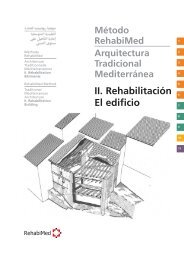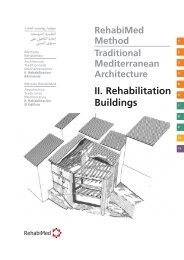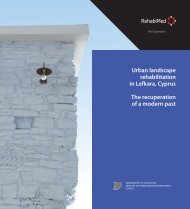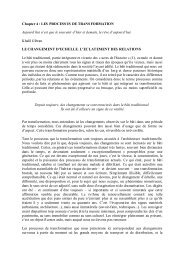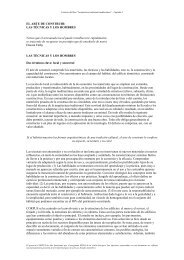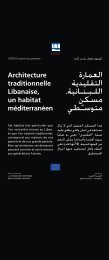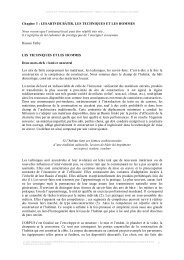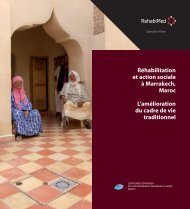La définition d'une stratégie d'intervention. La ... - RehabiMed
La définition d'une stratégie d'intervention. La ... - RehabiMed
La définition d'une stratégie d'intervention. La ... - RehabiMed
You also want an ePaper? Increase the reach of your titles
YUMPU automatically turns print PDFs into web optimized ePapers that Google loves.
<strong>La</strong> <strong>définition</strong> d’une <strong>stratégie</strong> d’intervention.<br />
<strong>La</strong> definición de una estrategia de intervención<br />
Defining a strategy for intervention<br />
valorising the tourist vocations of the area in the respect of the<br />
bonds that the territory imposes to the development of receptive<br />
and recreational activities (territorial coherence). At the same time, this<br />
bonds must follow the medium-long term trend of the tourist market,<br />
in order to guarantee a structural improvement of tourist activity<br />
( ). It is even necessary to propose to reach social<br />
(welfare, working) and economic (GDP level) targets, basis of any form<br />
of territorial development (institutional coherence).<br />
The proposal for a Tourist Sustainable Plan: an exemplification<br />
in the Cilento area<br />
<br />
Park and it is characterized by a fairly good tourist development on the<br />
coast (mainly constituted by holiday houses) that strongly collides with<br />
the internal areas, immersed in wonderful natural oasis and full of an<br />
architectural and cultural heritage, but hardly damaged by a socialeconomic<br />
and productive backwardness (pic.1).<br />
Hosting structures are very different (hotels, holiday camps,<br />
agrotourisms) and are mainly distributed along the seaside, as an<br />
ulterior demonstration of the dichotomy between the coast and the<br />
internal area (pic.2).<br />
On the results of a SWOT analysis of the area, it has been structured<br />
a planning proposal targeted on four strategic lines of interventions<br />
(Avoiding internal areas abandoning; Reducing population pressure on<br />
the coast; Improving the competitiveness and the attractive capacity<br />
of the area; Improving accessibility). Following these lines, specific<br />
objectives have been identified: among the other things, they are<br />
targeted to retrieve and promote activities linked to the rural natural<br />
and cultural resources, to attract more tourists in the area, to enhance<br />
and qualify tourist supply, to promote the area at a national and an<br />
international level.<br />
In particular, there have been many actions oriented to valorise the<br />
architectural heritage of the area. These actions have been articulated<br />
according to their representation in “point” interventions, “itinerary”<br />
interventions and “network” interventions, as it is easily visible in the<br />
table plan (pic.3).<br />
Point actions are essentially referred to historic centres: in particular,<br />
it could be instituted a living museum settled in the old downtown,<br />
“Il Cilento ieri e... l’altro ieri” (“The Cilento area yesterday and... the<br />
day before”), where some players (possibly local population) could<br />
periodically act scenes of ordinary life of the different civilisation<br />
that have settled along the centuries in the area, encouraging<br />
cultural exchanges, improving economic chances and giving a great<br />
prominence to places architecture, natural set of the playing. This<br />
activity could even be a support for an already spread initiative of a local<br />
Plan, called “Ospitalità da favola” (“Fairytale hosting”), that is targeted to<br />
constitute a network of houses destined to host the visitors of the Park.<br />
The Plan suggests not to build new structures but to draw on existing<br />
resources, retrieving, re-using, preserving and valorising them.<br />
In the itinerary choice it has been underlined the presence of the most<br />
valuable cultural points, identifying for example the religious itinerary<br />
“Il cammino di San Costabile” (“The path of St. Costabile”), based on a<br />
spiritual pursuit among churches, monasteries and cloisters; the cultural<br />
itinerary “Le roccheforti. la difesa del passato” (“The strongholds: the past<br />
defence”), where it is widespread the presence of mediaeval historical<br />
centres erected for a defensive aim; the cultural itinerary “Il percorso<br />
degli avvistamenti” (“The sighting path”), the only one following the<br />
whole seaside, that has been delineated in order to create a proper<br />
system among coastal towers, going through almost every commune.<br />
About networks, that involve local tradition museums and the pretty<br />
valuable historic centres, there have been planned virtual connections,<br />
so that it would be possible to link all the elements and to create a<br />
sole path thanks to some “infopoints”, both placed in the cultural sites<br />
and in places with great visibility inside and outside the area (bigger<br />
towns, exchange junctions of the local and regional network). Only for<br />
historic centres it is suggested the organisation of cultural events such<br />
as expositions, concerts, cultural exhibitions.<br />
186



